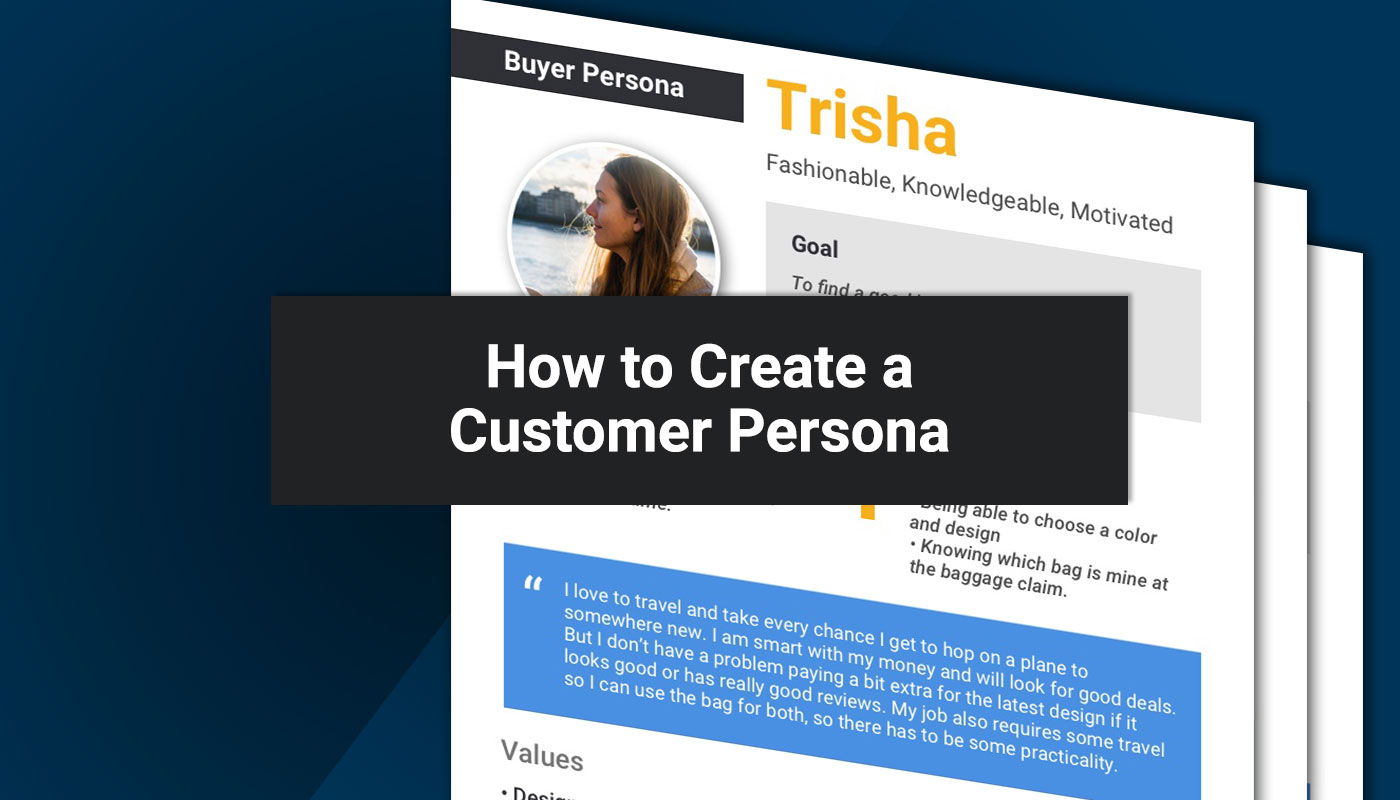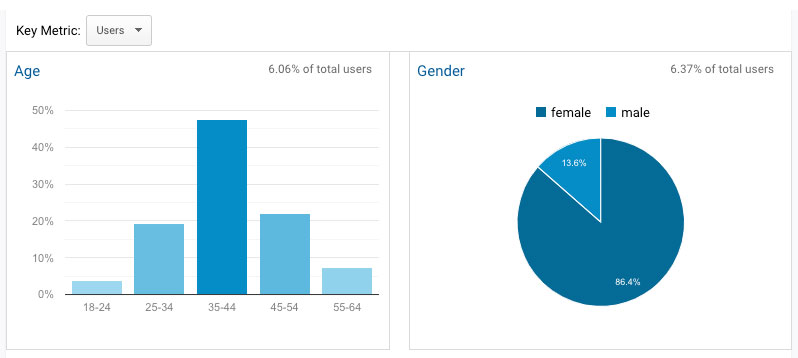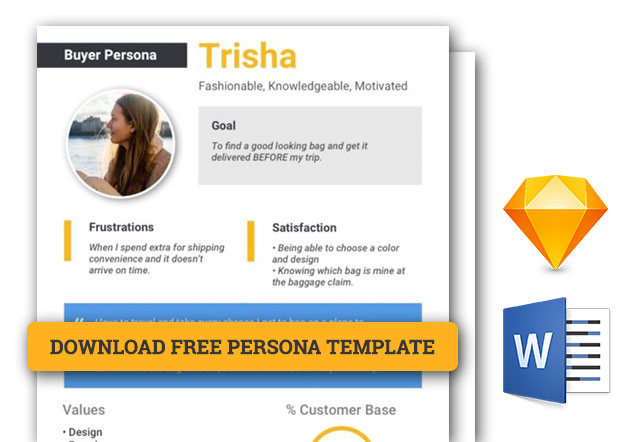How to Create a Persona
Jared Law
January 28, 2019

Getting to know your customer base through carefully crafted personas.
If you aren’t familiar with the term “customer persona” or why you would want to create a persona, here is a little background information. A persona is a representation of a particular segment of your customer base. A persona will typically be a combination of written descriptions, images, or other visuals represented in a single composition.
The goal of creating personas is to get a better understanding of who your customers are. It should be a big part of your overall digital marketing strategy and will help to define what drives your customers, what frustrates them, and what makes them happy.
It’s probably not a big surprise, but there are several advantages to understanding of your customer base better. Not only can it help you better target your messaging to influence their buying decisions. But it can also help you prevent customer service issues before they happen.
How Do I Create a Persona?
Creating your persona does take time and careful analysis. But to help you out we have created this comprehensive guide. Just follow along and you will be on your way to a better understanding of your customers.
Our process has 3 basic steps:
Customer Data Collection and Analysis
I think everyone would agree that it is better – and probably easier – making decisions based on
So the first piece of the puzzle is to start collecting and analyzing data.
Website Analytics
Hopefully, you most likely already have access to one solid collection of data. Just take a look at your website’s analytics. If you don’t have analytics set up on your site you’re missing out.
In your website’s
- What are the most common age groups
- Gender percentage breakdown
- What content is most visited
- What languages do they speak
- How many pages do your customers visit
- What content do they find interesting
- What social media channels do they use
- Are they mobile or desktop users
- What are their general demographics
- Where are they located
- How much research do they do before buying
Tools in Google Analytics that Help You Understand Your Customer Base
Audience > Overview
The audience overview is a really handy tool. Here you will have access to several pieces of information within a couple of clicks.
- Language preferences of your users
- Countries your site is being visited from
- Which cities generate most of your traffic
- Browsers being used
- Operating system (includes desktop and mobile OS)
- Service providers
- Screen resolutions
Audience > Lifetime Value
This tool is currently in beta so it may not always be there. But chances are pretty good so take advantage if you are operating an ecommerce store with conversion tracking enabled. It is a great source of information. For your persona building, it can tell you how your purchasing customers are finding you.
Audience > Demographics
This feature requires that you have a demographics feature enabled on your account. But once activated and data is being collected, you will start to see some great information for age and gender. The information doesn’t stop there though, you can drill into each segment to get even more information about your audience.

Audience > Interests
This is a great tool to see what general interests your audience has. It can also tell you what product purchase interests they have and other interest categories.
So Much More
There are a ton of other tools and features available on Google Analytics, letting you really get a deep dive into your customer base. Obviously this information doesn’t include name and email. But you will be surprised at the level of non-personally identifiable information you will be able to pull from it.
No analytics yet?
As noted earlier, if you don’t have analytics set up on your site, take the time to do so. It is a free service and can provide you a ton of insight on your customer base. You will find that installing analytics and conversion tracking will be well worth the investment. Keep in mind that while data collection is pretty immediate, you will want to wait a bit to get a large enough data sample to be statistically meaningful.
In the event that you are just launching your site or business and don’t have a site… You will have to get a bit more creative.
Ways to collect customer data without a website and analytics.
- Research published industry data
- Perform market research with targeted surveys
- Interview your current prospects or clients
- Contact businesses in complementary industries or tangent interest groups – they may be willing to share general demographic or technology statistics
If all else fails you can always fall back to pull answers out of your… hat. Creating assumed data points using your best educated guesses as to your audience demographic, gender, interests, and location.
Lead and Sales Data
In most businesses there are two distinct areas that data is collected, during the lead and sales process and after the sale.
CRM – Contact Relationship Management
Many companies will use a CRM to manage their sales opportunities. When implemented, a CRM will track data collected throughout the sales opportunity until a sale is made or permanently abandoned.
Unlike the analytics data indicated above, this data is often linked to personally identifiable information. That can be very useful but requires that you are asking for it and tracking it accurately.
What information should I be looking for in my CRM to build a persona?
The information pulled from your CRM is going to be much the same as in the website analytics section described earlier with a few more.
- Gender
- Age
- How they heard about you
- How many times did you have to connect with your customer to make the sale
- How long was the buyer experience
- What information were they interested in
- What questions did they have
- What was the determining factor in them choosing/not choosing your product or service
Online Reviews
Whether you like it or not, online reviews are a big part of today’s buying experience. Research has continually shown large percentages of your customers are doing research BEFORE they buy.
Check out BrightLocals updated 2018 local consumer report on local consumers and you will see that as much as 86% of consumers read reviews for local businesses.
In terms of your persona, the online reviews can tell you some great things about your customer base.
- What did they like about your business, product, or service
- What didn’t they like
- Would they recommend you to someone
- What was their perceived value of the food, product, service
- Were your sales or customer service nice, supportive, or other
All of this review information can help you create better personas by understanding what motivates your customer, what their pain points were, and what makes a satisfied buying experience for them.
Sales Data
Once a customer has gone through their sales journey and converted, they will likely find their way into your Sales or Customer Management tool. At the highest level this would consist of your accounting software. But there are a ton of other tools that you could be using.
If you are running an
If you are using PPC/SEM then you can also check
What data should I be looking for in my sales data to build a persona?
Your sales data will contain information about first time and (hopefully) repeat buyers. You are looking for any data that can be used to understand your actual customer base. Here are a few ideas of what to look for in your sales data.
- Gender
- Age
- How they heard about you
- What channels did they connect with you during their buying experience
- Average sales value
- % single purchases and repeat purchases
- % purchases with coupon codes
- % of shipping options used
- % of single item purchases vs multiple items
- Most popular products
Customer Support
If you are not doing so, please start keeping logs of your customer support issues. This data can be critical to understanding the goals, frustrations, and points of satisfaction of your customer base. All of which can help you sell better, smarter, and faster.
There are several ways that you can track customer support issues. If you are starting from scratch, then a simple shared spreadsheet will start you in the right direction. You may even have the ability already in your project management or
If you are ready to take customer service tracking to the next level then I would recommend a paid service or dedicated tool like Zendesk or Helpdesk.
What customer support data helps me create better personas?
- Reason for the complaint
- Product quality
- Shipping delivery
- Shipping damage
- Confusing instructions
- Cost
- Coupon issue
- Fit / Finish
- Was there a resolution
- Would you recommend us
- Satisfaction of product/service
- Satisfaction of support
- How they communicated their issue
Data Collection Example
Once you have reviewed your data, you will need to start compiling it into a usable resource. Below is an example collection of persona data that you can use for reference. Please note that the data points that you will need for your personas may vary based on the available data and your business model.
Data Points | Value |
|---|---|
Age Group 18-24 | – |
Age Group 25-34 | 25% |
Age Group 35-44 | 45% |
Age Group 45-54 | 20% |
Age Group 55-64 | 10% |
Age Group 65+ | – |
Gender – Male | 20% |
Gender – Female | 80% |
Location – US | 95% |
Language – En | 95% |
Mobile Traffic | 70% |
Desktop Traffic | 30% |
Mobile Checkout Traffic | 60% |
Desktop Checkout Traffic | 40% |
Social Media – Facebook | 65% |
Social Media – Instagram | 85% |
Social Media – Pinterest | 20% |
Social Media – Twitter | 25% |
Single Item Purchases | 35% |
Multiple Item Purchases | 65% |
Sales with Coupons | 70% |
One Time Purchase | 85% |
Two or More Separate Purchases | 15% |
Average Single Item Purchase Value | $150 |
Average Multiple Item Purchase Value | $380 |
Average Pages Visited Before Purchase | 12 |
Average Number of Sessions Before Purchase | 4 |
1st – Customer Support Issue | Shipping Cost |
2nd – Customer Support Issue | Damaged Product |
3rd – Customer Support Issue | Product Availability |
4th – Customer Support Issue | Product Usage |
1st – Reason for Purchasing Product | Product Rating |
2nd – Reason for Purchasing Product | Quality |
3rd – Reason for Purchasing Product | Price |
4th – Reason for Purchasing Product | Second Purchase |
The Big Sort
Once you have collected and created your data collection resource it’s time to start sorting through it. The goal of this step is to filter the data into sizable groups of people.
Most industry guidelines will state a goal of creating between 3 and 5 different personas. But don’t feel like you have to limit yourself to that few or that many. The premise behind the goal is to sort your customer base into a sizeable chunks that are representative of the largest customer types.
So if you have a customer base that is really diverse go for more. On the other hand, if you have a very narrow customer base you may only have a couple of major sorts.
What criteria could I use to sort my data and create a persona?
Start with the big easily identifiable demographic data like gender, age groups, location, device, etc… This will help you to quickly create the largest customer groups. From there you can continue to pare down these groups into smaller subsets.
Statistical Data
- Age groups
- Gender
- Location
- Language
- Social Media Usage
- Devices Used – Mobile/Desktop
- Coupon Usage
- Methods of Communication
- Customer Service Issues
- Likelihood of Repeat Customer
- Purchase Value
- Researcher/Impulse Buyer
Using the Example Data Collection we can start to put together a picture of what our customer base looks like.
We have a pretty good idea of our customer base from the age and gender. Based on our analytics data we see that 80% of our users are female and 20% are male. We can also see that our age demographics are primarily between 25 and 54, but with a small percentage above 55 (25% ages 25-34, 45% ages 35-44, 20% 45-54, and 10% 55-64).
Now it’s time to start the sort.
For the purposes of this demonstration we will have a target of 4 personas. Looking at the data I would recommend creating 3 users as female and 1 user as male.

Note: Some will say that you shouldn’t create personas using a specific gender. But they also insist on giving that persona a “representational” name and using an avatar image.
Unless you are going to be using gender neutral names and avatars this will be a constant source of confusion. So our recommendation is to go ahead and create personas of both female and male.
For the ages, we want to split up the personas based on the statistics. Though it is ok to make some assumptions about where those ages fall in the mix. As an example you could probably assume that the reported male demographic is going to lean toward the younger age groups.
We can then start to sprinkle the rest of the statistical data into the mix. Just try to provide some variety to make sure you have variances within your personas.
Example Personas
Persona 1
- Gender: Female
- Age: 27
- Country: US
- Language: English
- State: Florida
- Shopping Device: Mobile
- Purchasing Device: Mobile
- Social Media: Instagram, Facebook, Twitter
- Purchase Qty: Single Items
- Coupons: Yes
- Purchase Value: $150
- Researcher: Yes
Persona 2
- Gender: Female
- Age: 35
- Country: US
- Language: English
- State: Minnesota
- Shopping Device: Mobile
- Purchasing Device: Desktop
- Social Media: Instagram, Facebook
- Purchase Qty: Multiple Items
- Coupons: Yes
- Purchase Value: $400
- Researcher: Yes
Persona 3
- Gender: Female
- Age: 60
- Country: US
- Language: English
- State: New York
- Shopping Device: Mobile
- Purchasing Device: Mobile
- Social Media: Facebook
- Purchase Qty: Single Items
- Coupons: No
- Purchase Value: $250
- Researcher: No
Persona 4
- Gender: Male
- Age: 40
- Country: US
- Language: English
- State: California
- Shopping Device: Mobile
- Purchasing Device: Mobile
- Social Media: Facebook, Twitter
- Purchase Qty: Single Items
- Coupons: Yes
- Purchase Value: $200
- Researcher: No
Persona Character Development
At this point we have 4 different personas that we have created. Each one represents a different subset of our customer base but they are still pretty generic. So let’s start to add some flair and background. Some find it helpful to imagine each persona as a character in a play.
There are a few pieces of information that we want to add to the personas to make them seem a bit more real.
- Name
- Goals
- Frustrations
- Satisfaction
- Values
- Backstory
Name
We find that giving your persona a name to your persona can help you focus your creative and analytics powers. If you have elected to not use gender as a factor in your persona then look at using gender neutral names (Chris, Alex, Sam, Lee) or initials followed by a particular trait (G. Power User or D. Casual Shopper)
Goals
What is the objective of the customer when shopping on your site or looking at your service. Are they looking to find the best deal, best brand, fast support, or to just look good?
Frustrations
What pain points would this type of character be dealing with? This can include some of the major customer complaints or can be closer related to their goal.
Satisfaction
What provides satisfaction for this persona during their customer journey. Is it convenience, price, or the ability to impress their friends with their purchased products? All of these may be elements of the persona’s satisfaction.
Backstory
The backstory explains the persona’s basic background and personality. The information can include things like employment or marital status, personality, or anything else that will help you create the sense of this persona being a real person.
TIP: If creative writing isn’t really your thing, you may find creating a backstory a bit challenging. So, our recommendation would be to try to think through existing characters in movies or plays and
Values
What is it about your product or service that this person would value. The values should be one or two words long and be easily understood.
Character Development Example
Each character should be developed, for the purposes of
Persona 1 – Character Development
- Name: Tiffany
- Goals: To find a good looking bag and get it delivered before my trip.
- Frustrations: When I pay extra for shipping and it doesn’t arrive on time.
- Satisfaction:
- Being able to choose a color and design
- Knowing which bag is mine at the baggage claim
- Backstory: I love to travel and take every chance I get to hop on a plane to somewhere new. I am smart with my money and always look for good deals. I
don’t have a problem paying a bit extra for the latest design if it looks good or has really good reviews. My job also requires some travel so I can use the bag for both, so there has to be some practicality. - Values:
- Design
- Brand
- Features
- Shipping
- Functionality
Establishing Marketing Profile
Our personas should also include information to help us understand how they should be marketed to. This information can include several factors. Some of the marketing profile factors can be pulled from the data collection. While others will need to be created based on best estimates.
Marketing Profile Details
- Methods of Communication
- Product Knowledge
- Times on Site
- Device
- Social Networks
Persona 1 – Marketing Profile Details
Methods of Communication
- Phone
Product Knowledge: High
Time on Site
- 9pm – 11pm
- 8:30am – 9:30am
Device: Mobile
Social Networks
Putting it all Together to Create a Persona
At this point we should have all the data, character development, and marketing profile information needed to put it all together and create the complete persona.
You can create your persona in any tool that you wish. We typically use Sketch, but you can certainly use whatever you are comfortable with or have access to.
To lend a hand, we have created a couple of templates that you are free to download and use.
Looking to understand your customers better?
Partner with Fuzzy Duck to create your complete customer personas. Our marketing team will work with you to get a better understanding of who your customers are and what they are looking for.
